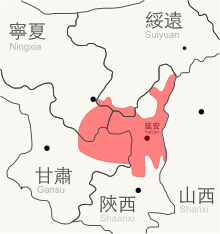Shaan-Gan-Ning_Border_Region
Yan'an Soviet
Communist-governed Chinese base area (1937–1950)
The Yan'an Soviet was a soviet governed by the Chinese Communist Party (CCP) during the 1930s and 1940s.[1] In October 1936 it became the final destination of the Long March, and served as the CCP's main base until after the Second Sino-Japanese War.[2]: 632 After the CCP and Kuomintang (KMT) formed the Second United Front in 1937, the Yan'an Soviet was officially reconstituted as the Shaan–Gan–Ning Border Region (traditional Chinese: 陝甘寧邊區; simplified Chinese: 陕甘宁边区; pinyin: Shǎn-Gān-Níng Biānqū; lit. 'Shaan-Gan-Ning Border Region').[lower-alpha 1][3]
You can help expand this article with text translated from the corresponding article in Chinese. (January 2022) Click [show] for important translation instructions.
|
